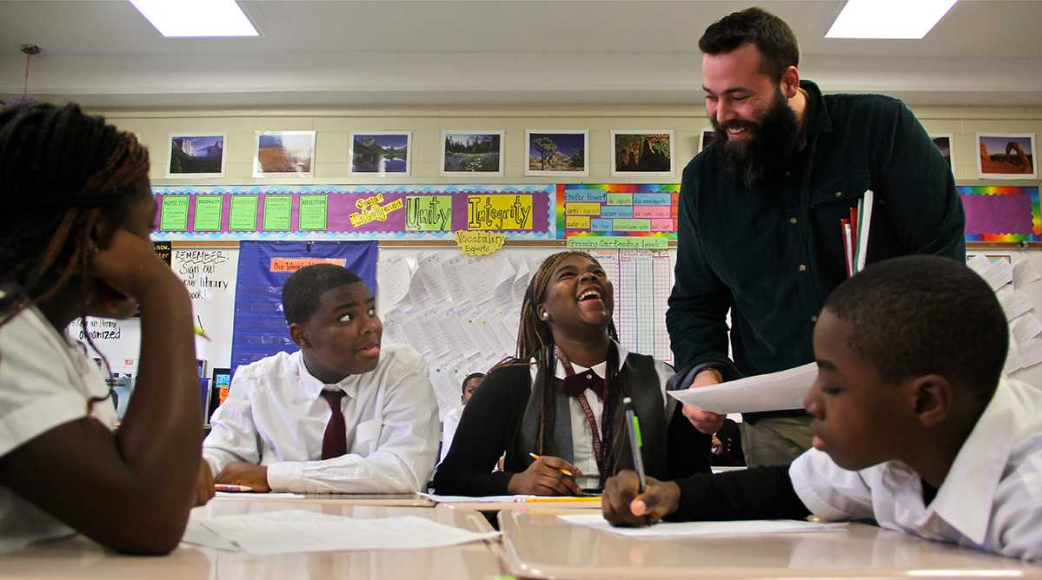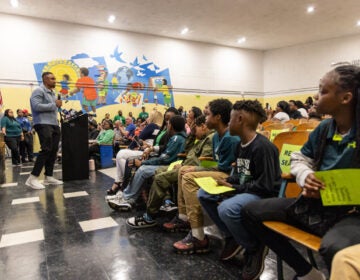Does Philadelphia have a teacher vacancy problem? It’s a multiple choice answer

Teacher Andrew Brooking works with students at Blaine Elementary School in Philadelphia. (Emma Lee/WHYY)
Does the School District of Philadelphia have a staffing problem? And if so, what can be done to solve it?
Those were the primary questions zipping around City Hall Monday as Philadelphia City Council’s Education Committee held a hearing on teacher retention and recruitment in the city’s public schools.
The topic has clear political implications.
Philadelphia’s teachers have been without a contract for more than three years as they have gone without raises or cost-of-living adjustments. Because the union cannot strike under state law, it has little leverage beyond public pressure. The union has routinely drawn attention to teacher hiring woes and cited them as evidence that the ongoing negotiations have weakened city schools.
Mayor Jim Kenney and Councilwoman Helen Gym — who provided much of the rhetorical punch during the Monday hearing — both benefited from union support during their campaigns and have pushed hard for a new contract.
District officials, meanwhile, said they’ve put a solid offer on the table and cannot stretch much further due to long-term money woes. They also dispute that the contract stalemate has hamstrung the district’s ability to staff its schools.
Where you fall on the argument depends on how you interpret the data coming from the school district and the anecdotal evidence coming from veteran teachers — a number of whom testified Monday.
The district has just over 8,000 teaching positions. At present, 94 full-time teacher vacancies exist, officials say.
This spring, the district announced an aggressive hiring push and set a goal of filling every full-time teaching position for the start of the 2016-17 school year — a target it has hit in the past. In June, the district announced it was on track to meet that mark, but by the time school started 59 vacancies remained.
On Monday, Uri Monson, the district’s chief financial officer, said the number of vacancies at the beginning of the school year was still the lowest it’s been since 2013 and lower than 11 of the past 18 years. He also noted that the district’s teacher vacancy rate — just over 1 percent — compared favorably with the city’s employee vacancy rate, which sits at 6.5 percent.
The district hired 1,000 new teachers for the current school year and has been able to fill 200 of the 300 teaching slots that have opened since the beginning of the school year. Monson said the numbers are proof that “people want to teach in Philadelphia.”
“This is an incredible accomplishment for any business or school district of our size,” he said.
Teachers feel ‘demoralized’
Critics, however, painted a less rosy picture.
“We can no longer comfort ourselves with the notion that this year’s number of vacancies is an improvement over last year,” said union head Jerry Jordan. “Because, quite frankly, our schoolchildren and parents deserve much better.”
Gym’s office estimates that the current staffing shortage leaves 5,710 city students without a permanent teacher for at least some part of the day. Data compiled by the union, meanwhile, found 181 vacancies in support positions and 613 oversized classes. And for some non-teaching positions, the vacancy rates are far higher. For instance, just 59 percent of building engineer positions in the district were filled as of Nov. 8.
Some teachers, meanwhile, said the ongoing contract woes are driving teachers out of the profession or into neighboring districts where they can find better pay and more stability. Young teachers have been hit especially hard. Some who have been with the district for up to five years remain stuck at their starting salary. Even among those who’ve stayed, said speech pathologist Sonya Britnall, the absence of a new permanent deal has sowed discontent and unease.
“Right now all we talk about is how demoralized we are,” said Britnall.
Melissa Lawson, a school counselor at Science Leadership Academy’s Beeber campus, said many of her peers are seeking greener pastures.
“I’ve seen many of my colleagues come and go because their lifestyles aren’t sustainable with the pay that were are currently receiving,” she said. “Teachers are coming to school burnt out and tired from working two jobs just to stay afloat.”
District officials, however, said the numbers don’t support the perception that teachers are fleeing Philadelphia en masse. The district’s year-to-year retention rate was a hair over 90 percent this school year, almost exactly the same as it was a year ago and in 2012-13.
Some improvement
There was, however, at least one point on which all seemed to agree: the situation in Philadelphia schools is at least better than it was last year, when there were 118 teacher vacancies on the first day of school. Compounding the problem was a disastrous substitute shortage that left many schools unable to secure replacement teachers.
The district switched to a new substitute teacher contractor this year and the fill rates have shot up to 75 percent — still below most suburban districts, but above the district’s historical averages, officials said.
That improvement however hasn’t satisfied Gym, who who has relentlessly needled the district over what she sees as its staffing shortcomings.
She pressed the district to provide summer school for students shortchanged by last school year’s vacancy woes. Her office also filed a complaint with the state pertaining to special-education students who didn’t have their individualized education plans met due to staffing problems.
On Monday, Gym connected the staffing to larger political issues and ideological differences over how to best fix the city’s schools. She emphasized that the union contract has become an impediment to teacher retention. She also pointed the finger at district-led interventions that can lead to — and sometimes even cause — high turnover at low-performing schools.
“To keep the committed professionals who’ve weathered years of cuts and pay freezes to stay in their schools and teach their students we have to move past some unproven turnaround strategies premised on removing 50 percent of our teachers,” said Gym.
Contract deal remains elusive
Through much of the evening, though, conversation drifted back to the teacher’s contract.
A recent report from the Philadelphia Inquirer detailed the district’s latest proposal, a $100 million increase over the current rate that would reinstall salary steps but would not compensate teachers for the raises they’ve missed over the last five years. The union has not publicized its counteroffer, although all indications are that the sides remain far apart.
“We need to recognize the impact on those teachers who are working without a contract and without raises in oversized classrooms and decayed buildings,” Gym said.
Teachers said a new contract, more resources, and greater respect from the higher-ups at district headquarters would go a long way toward reversing the vacancy trend.
“We don’t want to walk out on our students, but we feel powerless,” said LaShawna Coleman, a 16-year veteran of the school district. “We are in situations where respect and support are lacking, but the expectations are enormous.”
District officials, however, said they’re on the right track and could close the gap further with some continued tinkering. They believe giving principals more autonomy in the hiring process and starting that process earlier could improve the district’s fill rate.
WHYY is your source for fact-based, in-depth journalism and information. As a nonprofit organization, we rely on financial support from readers like you. Please give today.





